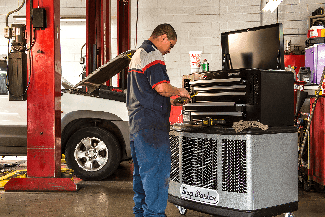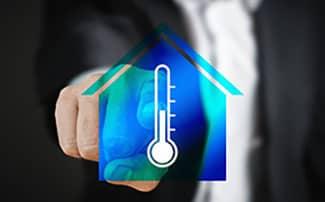It may be one of the most irritating things about our long, hot summers: You have a super-hot garage you hardly use in June, July and August, except as a parking space for your car.

And everybody knows the rules: Don’t store any fragile Christmas decorations or your wedding dress or precious photos in the garage because the summer heat can damage them. And don’t run in the house after a trip to the grocery store without bringing in the milk and lettuce. Remember, if you hope to clean out your garage one of these days, do it now, because it will be in the mid-90s or more in your garage very soon if not already.
Homeowners ask us all the time how they can cool off that garage so that it can be used as a workshop or place to tinker on cars or as a man cave or woman cave or a place to keep pets or an area where you can work out in peace. What follows are answers to the biggest questions:
Will installing a ventilation fan help my garage’s temperature?
Probably not. It will run all the time, burn up kilowatts and do very little to cool off your garage.
Will a portable evaporative cooler or mini-split air conditioner cool off the garage?

These two methods are the best options, and that evap cooler is the least costly. You simply wheel it out and connect it during the summer. Evap coolers use tap water to saturate a pad made of shredded wood or specially designed cellulose paper material. The hot outside air is pulled through the pad and absorbs moisture. The cooler can produce air in your garage that is as cool as 70 even on a 100-degree day. One thing to keep in mind during high humidity, mainly monsoon storms, you will notice a reduction in the cooling effect. These coolers can cost from $300 to over $3,000 for industrial models or you can find the 3-1 (Evap Cooler+Tool Box+Stereo) ShopBlaster by Phoenix Manufacturing available through the Rosie eStore.
For more on Mini-Split Air Conditioners see our blog: What Is a Mini-Split and What Are the Benefits?
How do you insulate the inside of the garage?

To start, Petre says, crews will drill holes in walls and access the attic, possibly through a hatch. If there is no hatch, they can still provide access in the garage ceiling. The holes that are drilled are used to blow foam or fill insulation into walls and ceiling. If you have a flat roof, you can still insulate the ceiling; however, many holes will need to be drilled there as well. Afterward, the holes are patched. Homeowners generally repaint the walls themselves. But Banker insulation is a licensed general contractor and can provide the patching and painting if desired.
What will insulating the garage do to utility bills?
Once the job is done and an evap cooler or AC is installed, there may not be significant savings in power bills, but the temperature in the garage will drop. This renovation probably won’t do much to cool off the rest of the house.
What if you have a flat roof?

You can insulate the ceiling using the drill and fill method which again requires patching the drywall after insulation. Otherwise, you won’t achieve efficient cooling with your AC or evap cooler.
Can insulating a garage door be a do-it-yourself project?
You can buy relatively inexpensive kits at big-box stores for insulating a garage door yourself. However, the kits are far less effective than the two-inch-thick insulation a licensed garage door company would install.
Garage Door Tip:
The insulation will often add weight to the door so that the springs won’t operate properly. That weight can also cause your automatic garage door opener to malfunction. He estimates it would cost $200 to $300 to insulate the door and $300 more for installing stronger springs. Instead, consider buying a brand-new, insulated garage door. Possible cost: $1,500. But then everything will work properly.
Keep in mind that even if you insulate the garage and cool it off with an AC or evap. cooler, you’ll still heat it up a bit every time you pull a car with a red-hot engine into your garage.
###
Photo Credits:


















